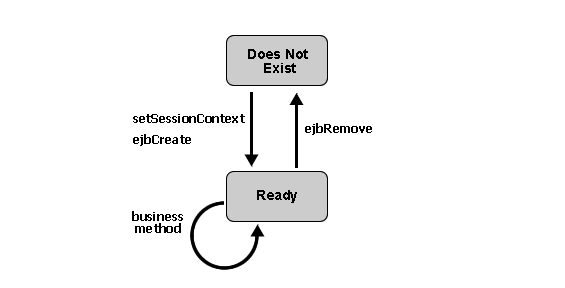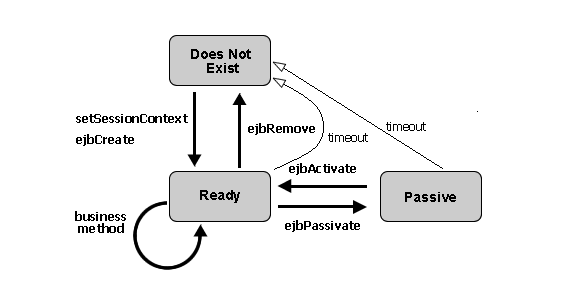This topic discusses the life cycle methods of session beans and contains the following sections:
The following figure shows the life cycle of a stateless session bean. A stateless session bean has two states:
The various state transitions as well as the methods available during the various states are discussed below.

When the EJB container creates a stateless session bean instance to be placed in the ready pool, it calls the callback method public void setSessionContext(SessionContext ctx). This method has the parameter javax.ejb.SessionContext, which contains a reference to the session context, that is, the interface to the EJB container, and can be used to self-reference the session bean object. Complete details about the javax.ejb.SessionContext can be found in your favorite J2EE documentation and the API reference at http://java.sun.com.
After the callback method setSessionContext is called, the EJB container calls the callback method ejbCreate. You can implement this callback method to, for instance, obtain the home interfaces of other EJBs invoked by the session bean, as shown in Defining a Session Bean. The ejbCreate method is only called once during the lifetime of a session bean, and is not tied to the calling of the create method by a client application. For a stateless session bean, calling the create method returns a reference to a bean instance already in the ready pool; it does not create a new bean instance. The management of stateless session bean instances is fully done by the EJB container.
When a bean instance is in the ready state, it can service client requests; that is, execute component methods. When a client invokes a business method, the EJB container assigns an available bean instance to execute the business method. Once execution has finished, the session bean instance is ready to execute another business method.
When the EJB container decides to reduce the number of session bean instances in the ready pool, it makes the bean instance ready for garbage collection. Just prior to doing this, it calls the callback method ejbRemove. If your session bean needs to execute some cleanup action prior to garbage collection, you can implement it using this callback method. The callback method is not tied to the remove method invoked by a client. For a stateless session bean, calling the remove method invalidates the reference to the bean instance already in the ready pool, but it does not move a bean instance from the ready to the does not exist state, as the management of stateless session bean instances is fully done by the EJB container.
The following figure shows the life cycle of a stateful session bean. It has the following states:
The various state transitions as well as the methods available during the various states are discussed below.

When a client invokes a create method on a stateful session bean, the EJB container creates a new instance and invokes the callback method public void setSessionContext(SessionContext ctx). This method has the parameter javax.ejb.SessionContext, which contains a reference to the session context, that is, the interface to the EJB container, and can be used to self-reference the session bean object. Complete details about the javax.ejb.SessionContext can be found in your favorite J2EE documentation and the API reference at http://java.sun.com. After the callback method setSessionContext is called, the EJB container calls the callback method ejbCreate that matches the signature of the create method.
A stateful bean instance in the ready state is tied to a particular client for the duration of their conversation. During this conversation the instance can the execute component methods invoked by the client.
To more optimally manage resources, the EJB container might passivate an inactive stateful session bean instance by moving it from the ready state to the passive state. When a session bean instance is passivated, its (non-transient) data is serialized and written to disk, after which the the bean instance is purged from memory. Just prior to serialization, the callback method ejbPassivate is invoked. If your session bean needs to execute some custom logic prior to passivation, you can implement it using this callback method.
If after passivation a client application continues the conversation by invoking a business method, the passivated bean instance is reactivated; its data stored on disk is used to restore the bean instance state. Right after the state has been restored, the callback method ejbActivate is invoked. If your session bean needs to execute some custom logic after activation, you can implement it using this callback method. The caller (a client application or another EJB) of the session bean instance will be unaware of passivation (and reactivation) having taken place.
If a stateful session bean is set up to use the NRU (not recently used) cache-type algorithm, the session bean can time out while in passivated state. When this happens, it moves to the does not exist state; that is, it is removed. Prior to removal the EJB container will call the callback method ejbRemove. If a stateful session bean is set up to use the LRU (least recently used) algorithm, it cannot time out while in passivated state. Instead this session bean is always moved from the ready state to the passivated state when it times out.
The exact timeout can be set using the idleTimeoutSeconds attribute on the @Session annotation. The cache-type algorithm can be set using the cacheType attribute on the same annotation.
When a client application invokes a remove method on the stateful session bean, it terminates the conversation and tells the EJB container to remove the instance. Just prior to deleting the instance, the EJB container will call the callback method ejbRemove. If your session bean needs to execute some custom logic prior to deletion, you can implement it using this callback method.
An inactive stateful session bean that is set up to use the NRU (not recently used) cache-type algorithm can time out, which moves it to the does not exist state, that is, it is removed. Prior to removal the EJB container will call the callback method ejbRemove. If a stateful session bean set up to use the LRU (least recently used) algorithm times out, it always moves to the passivated state, and is not removed.
The exact timeout can be set using the idleTimeoutSeconds attribute on the @Session annotation. The cache-type algorithm can be set using the cacheType attribute on the same annotation.